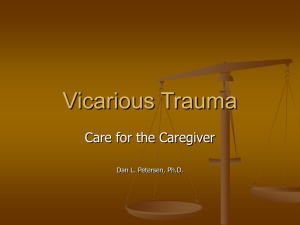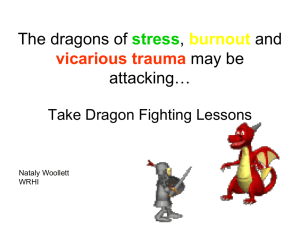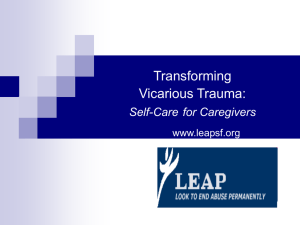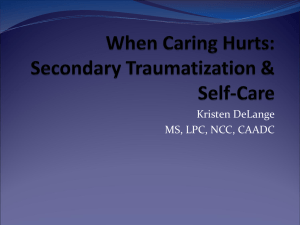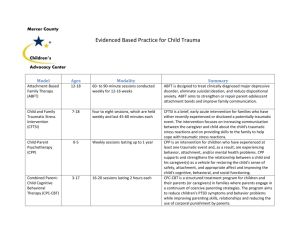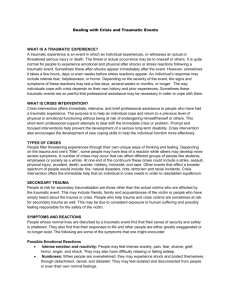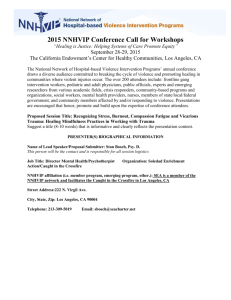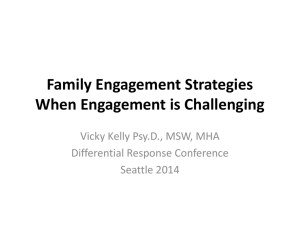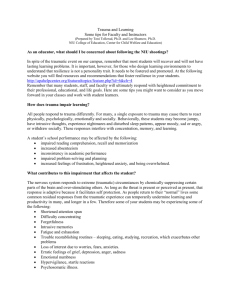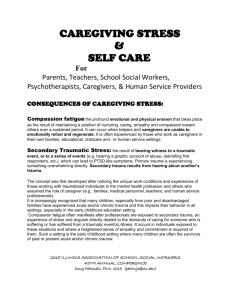VT_Conference_Presentation_EUSARF_2014
advertisement
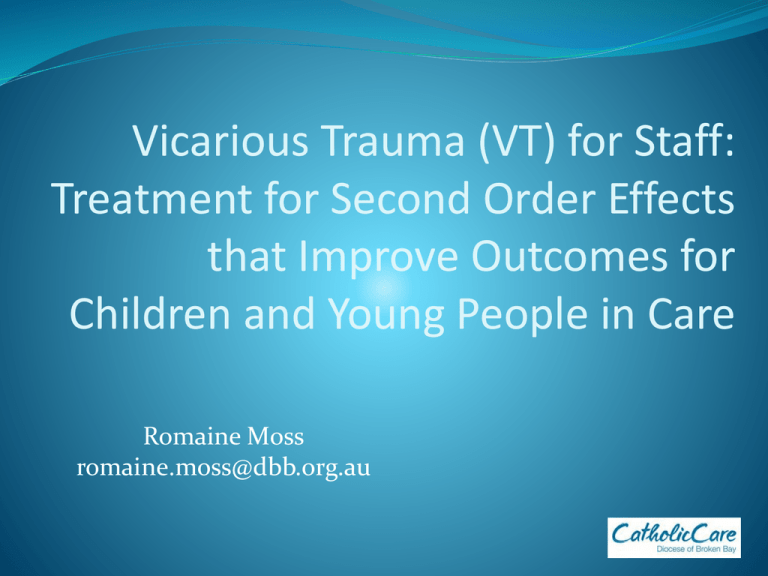
Vicarious Trauma (VT) for Staff: Treatment for Second Order Effects that Improve Outcomes for Children and Young People in Care Romaine Moss romaine.moss@dbb.org.au Our Out of Home Care Service Category 6 Intensive Support Service 6 residential care houses -accommodate up to 4 young people (10-18 years) 70 residential care workers – permanent & casual 24/7 rostered Residential Care Workers Staff range in age, educational and employment backgrounds Background • High turnover – loss of knowledge & consistency • High number of incident reports • Complex and costly workers compensation claims • Disempowered Staff – unconsciously identifying as victims Elements of VT • Burnout - long-term exhaustion & diminished interest • Secondary Traumatic Stress – similar symptoms to PTSD • Compassion Fatigue – gradual lessening of compassion • Vicarious Trauma – “The effects of hearing about or witnessing the aftermath of traumatic events” • Often suffered in helping professionals where workers are required to take part in empathic interaction with trauma survivors (Pearlman & Saakvitne, 1995) Vicarious Trauma Detrimental Effects Secondary Traumatic Stress Re-experiencing Avoidance Hyper arousal Cognitive Changes Frame of Reference changes Self Capacities Disruption to psych needs Pearlman’s ABC Model of Managing VT Awareness of the effects of VT Balance of work and life Connection with people and community Essential Components of our VT Management Program 1. Education 2. Risk reduction strategies 3. Monitoring for VT symptoms 4. Early Intervention of VT symptoms 5. Promoting longer term wellbeing Aim to retain staff in better psychological health to improve outcomes for Young People in care 1 1. Education Acknowledge that VT is inevitable in this work Understand the construct of VT Recognise the symptoms of VT Strategies to manage VT 2. Risk Reduction Strategies – Leaving work at work Risk Reduction strategies that Reduce exposure to trauma content by building capacity for individual to “leave work at work” Physical & psychological rituals Flexible work arrangements 1 3. Monitoring for Symptoms Critical incident monitoring VT Testing – Biannual 1. Compassion Fatigue Self Test for Practitioners (CFST – Figley 1995) Scores for risk of Compassion Fatigue & Burnout 2. Trauma Attachment Belief Scale (TABS – Pearlman 2003) Scores for cognitive schemas about self & others 10 subscales – (Safety, trust, esteem, intimacy & control) x (self or others) 4. Early Intervention of Symptoms Supervision Defusing/debriefing following critical incidents Employee Assistance Program (EAP) VT Intervention Support Line 5. Promoting Wellness - Self Care Self Care strategies that: Address the individual’s VT profile - target symptoms most experienced or most severely. Actively oppose the results of VT – attempt to offset symptoms & reduce problematic impacts on the worker Funded and non funded Research Project (2013 – 2015) Methodology Combined quantitative and qualitative methods/2 phases Phase 1: Comparative analysis of VT testing (2 x biannual tests – CFST & TABS) 12 month qualitative survey (closed & open ended questions) 12 month analysis turnover, sick leave & worker’s compensation data. Phase 2: Repeat above analysis in 12 months Evaluation of tailored individual self care plans and VT Intervention Support Line Analysis of Incident report data Phase 1 - Qualitative Survey results (2013 -2014) Supervisors n= 6 & Residential Care Workers n=38 70% engaged in funded & 87% engaged in non funded self care 58% positive impact on team, 52% positive impact on house “by constantly discussing at supervision I am able to talk about things before they get worse” “its positive because workers feel more taken care of. .” Being more relaxed at work provides a sense of calm to the children” Phase 1 - Cognitive Test Results No difference in change in VT levels (n = 34) TABS – average to low average range, slight downward trend but not significant CFST - population at high risk for experiencing secondary traumatic stress symptoms Phase 1 - Organisational bottom line 24 % drop in turnover, 23% drop in sick leave, 48% drop in workers compensation leave Initial Recommendations to Manage VT Acknowledge the risks – build a culture of inevitability Reduce the risk – Professional development, supervision & shift handover Early Intervention – debriefing, VT Support, EAP. Monitor Symptoms – direct & indirect monitoring Build Resilience – individual nature of VT, tailored self care Quotes: “Becoming a Therapist: When trying to help a broken person always remember that you will be hurt by their shattered pieces and that is okay.” (Cornercanyoncounselling.com) “In dealing with those who are undergoing great suffering, if you feel “burnout” setting in, if you feel demoralised and exhausted, it is best, for the sake of everyone, to withdraw and restore yourself. The point is to have a long term perspective” Dalai Lama Thank You... I would like to acknowledge the work & dedication of Michael Cashin (OOHC Manager), our 6 house coordinators & staff for the amazing work that they do. I would like to thank the following organisations for their support of our program. Catholic Social Services Australia (CSSA) Rape and Domestic Violence Services Australia Contact details: Romaine Moss (romaine.moss@dbb.org.au)
